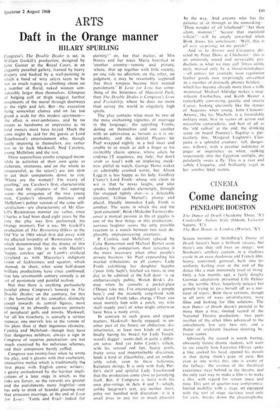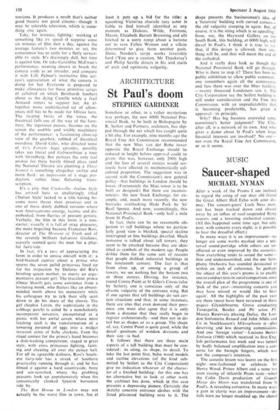CINEMA
Come dancing
PENELOPE HOUSTON
The Dance of Death (Academy Three. 'A') Cinderella—ltalian Style (Odeon, Leicester Square, 'U') The Best House in London (Warner, 'X') Screen versions of Strindberg's Dance of Death haven't been a brilliant success, but there's one that still fixes an image: von Stroheirn's artillery captain, in a shadowy castle in an even shadowier old French film. heavy, contained, guttural, built into his uniform, keeling over at the end of the dance like a man immensely tired of living Only a few months ago, a fairly doughy German adaptation presented Lilli Palmer as the terrible Alice, hopelessly miscast but gamely trying to pass herself off as a nur- turer of vipers. Both these versions. though in all sorts of ways unsatisfactory, were films and looking for film solutions. The new Dance of Death doesn't pretend to be more than a true, limited record of the National Theatre production: two parts (neither of the other films advanced to the anti-climatic last act), two sets, and a flutter of irrelevant location shooting be- tween scenes.
Obviously the record is worth having: obviously future drama students will want to see exactly how Laurence Olivier spoke a line, cocked his head, opened his mouth in that dying shark's gape of pain. But even as one writes this, one is aware of the fallacy: the essence of the theatrical experience stays behind in the theatre, and the only real way to make a film is to make a Thu, with regard for screen space and time. This sort of quarter-way compromise. limited mobility with a stagy set equipped with the sort of stage staircase used only for exits, breaks down the claustrophobic
tensions. It produces a result that's neither good theatre nor good cinema—though it may be tolerable television, which is some- thing else again.
Take, for instance, lighting: working at something like TV speed (I suppose some six minutes of film shot a day, against the average feature's two minutes or so), the cameraman has to settle for a flatly service- able Tv style. It's drainingly dull, but time is against him. Or take Geraldine McEwan's performance, seeming almost to brush the camera aside as an intruder, and compare it with Lilli Palmer's instinctive film act- ress's appreciation of what the camera is doing for her. Everyone is prepared to make allowances for those primitive scraps of celluloid on which Bernhardt lumbers about as the dying Camille while a frail Armand totters to support her. An al- together more sophisticated set of allow- ances still has to be made for Olivier here. The rasping twists of the voice, the theatrical falls out of the way of the furn- iture, the ingenious pauses, become on the screen the audible and visible machinery of the performance: a fascinating close-up view of the gearbox, robbed of theatrical overdrive. David Giles, who directed some of TV's Forsyte Saga episodes, possibly takes too literal and Galsworthian a tone with Strindberg. But perhaps the only real answer for these barely filmed plays (and the National Theatre are planning a Three Sisters) is something altogether swifter and more fluid: an impression of a stage pro- duction, rather than flattening trans- scription.
It's a pity that Cinderella—Italian Style has arrived here so unalluringly titled ('Italian Style' tacked to a title having be- come more threat than promise) and in one of those dimly dubbed versions where wan Americanisms emerge, laconic and dis- embodied, from flurries of peasant gesture. Verbally, the film in this form is a non- starter; visually it is full of stray pleasures, the more beguiling because Francesco Rosi, director of The Moment of Truth and of the severely brilliant Salvatore Giuliano, scarcely seemed quite the man for a play- ful fairy-tale.
In fact, it's a case of appreciating the form in order to amuse oneself with it: a bird-brained caprice' about a prince who spurns the seven pallid princesses lined up for his inspection by Dolores del Rio's bristling queen mother, to marry an argu- mentative peasant girl. The truculent prince (Omar Sharif) gets some assistance from a levitating monk, who flutters like an absent- minded moth above his monastery while his colleagues try to talk their silly saint down to do his share of the chores. The girl (Sophia Loren, the sophisticate in the cabbage patch) is aided by a nonchalantly incompetent sorceress, encountered at a picnic with her awful coven, whose most fetching spell is the transformation of a towering pyramid of eggs into a midget invasion army of baby chickens. Even the ritual contest for the prince's hand becomes a dish-washing competition, staged in great style, with cross princesses fighting, faint- ing and cheating all over the palace hall.
For all its agreeable daftness, Rosi's South- ern fairy-tale has a streak of Southern practicality running through it; and he has filmed it against a hard countryside, bony and sun-scorched, where the grubbing peasants look up apprehensively when the romantically cloaked Spanish horsemen ride by.
The Best House in London may not actually be the worst film in town, but at least it puts up a bid for the title: a squeaking Victorian charade (any actor is liable to find himself identified at any moment as Dickens, Wilde, Fortnum, Mason, Elizabeth Barrett Browning. and all) hitched to a sorry romp about a heroine out to save Fallen Women and a villain determined to give them another push. Denis Norden's script works feverishly hard ('You are a caution, Mr Thackeray') and Philip Saville directs in fits and starts of arch and optimistic vulgarity.



































 Previous page
Previous page